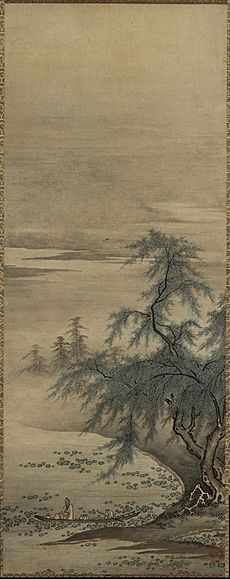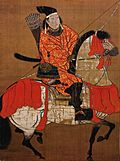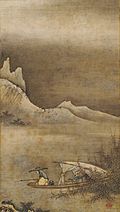Kanō Masanobu facts for kids
Kanō Masanobu (狩野 正信, 1434? – August 2, 1530?, Kyoto) was a very important Japanese painter. He was the main artist for the Ashikaga shogunate, which was the government at the time. Many people see him as the person who started the famous Kanō school of painting. Masanobu was known for his Zen paintings and detailed artworks of Buddhist gods and spiritual figures.
Masanobu's Life and Art
Masanobu's father, Kanō Kagenobu, was a samurai who also enjoyed painting as a hobby. Masanobu was the first in his family to become a professional artist. He learned a lot from the priest and painter Tenshō Shūbun. Some people even say that Shūbun taught him most of what he knew about art.
Masanobu often painted in a style called suiboku. This style uses ink and water, much like Chinese painting. However, Masanobu added his own Japanese touch, making the shapes in his paintings clearer and more defined. Not many of his artworks still exist today. One special painting that has survived is Zhou Maoshu Appreciating Lotuses.
Kanō Masanobu became an official painter for the Muromachi government. This was a very important job. Even though his family were samurai, they were not from the main court. He earned his position because he was very talented and well-connected. Some people, like an aristocrat named Shūzan Tōki, didn't like this. They felt he wasn't "born" to be a court painter.
The Kanō School's Lasting Impact
The Kanō school of painting became very powerful and popular. It stayed important for over 400 years, from Masanobu's time until the Meiji Restoration in 1868. However, the unique style of the Kanō school isn't just from Masanobu. His son, Kanō Motonobu, took over the school after him. Motonobu played a big part in shaping the distinct Kanō style that became so famous.





